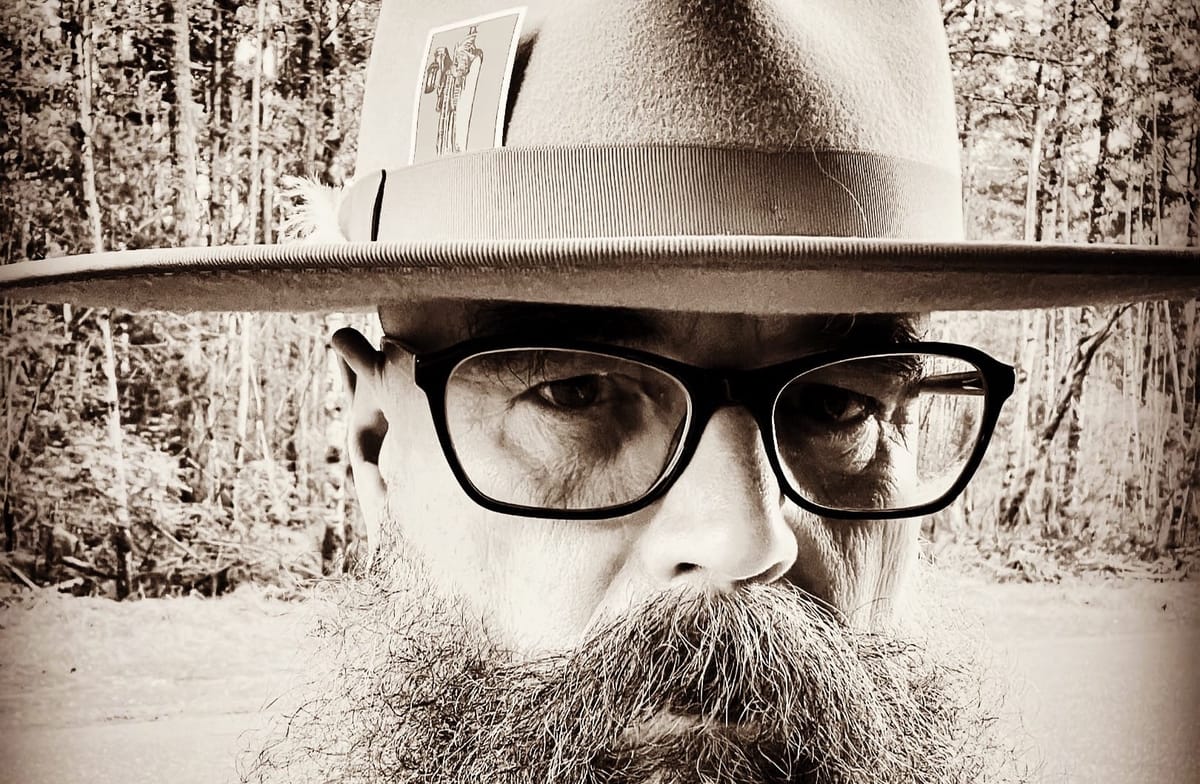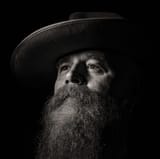CHAPTER 123: YOUR PRACTICE, YOUR ATTENTION, YOUR HOLINESS (Part I)

Apprenticeship to Love, April 23, 2024
- Today’s questions: What happens when you slow down, almost to the point of being still? What changes? What doesn't change? Now, slow yourself a little more. Notice what begins to open, to move, within and without. Are you willing to allow this to be enjoyable, this almost-still attending to the moment within and without?
- Today's suggested practice: Day 23 of this month's practice, to pause and feel the sacred space within and without (see my "Short Practice,” below)
- My practice today: 3:30am: 60 minutes: yoga asanas (physical practice) including Sarbhang dande kriya, mantra meditation for balancing polarities and expanding the heart.
- On May 13 Fabiola Perez and I will host Vagina, a conversation for men, free to all on the "1000 Early Readers" list at Apprenticeship to Love. Register at http://menswork.ca
TODAY'S MEDITATION
A few days ago my colleague Sarah Anderson led our monthly Apprenticeship to Love virtual workshop. She guided us through a simple exercise. On the face of it, nothing special. But in the doing of it...
Writing this I remember the feeling of being disoriented. Opened. Vulnerable. Alive to the moment, yet needing to be held, somehow, in place because the disorientation was a little... "too much." Yes. Too much. How the feminine is so often experienced in the masculine body: as too much.
More recently a man asked me, How do I deal with this "too much," in a practical way? We'll get to that in a moment.
...
Maybe it's the time of year. Or maybe it's the time of this culture. So much yearning for love and purpose, and so little to tether this yearning, to ground it and hold it, gently, to allow it to blossom.
I am listening to the hearts of younger men and women as they wonder aloud, How...?
I can't say that I know the way for anyone else. I am, if you've been reading, asking myself the same question, fumbling my own way towards an answer. Here is what I believe to be true for all of us —or at least, all of those with whom I've had the pleasure to share the intimacy of this wondering, whether as students or colleagues, or as my beloved: Stephen Jenkinson is right when he speaks of a need, in this culture, to learn the skill of heartbreak, of grief. He asserts that it is in our heartbreak that we know ourselves undeniably alive. The only way to develop this skill is to practice. In a different but related way, it's what John Wineland calls "making death our ally."
...
My marriage is a garden. Not a single flower, but the whole garden. Even as one part of it comes into bud or blossom, another part is going deeper into the dark and rooting itself, and another part is withering, and another, dying.
We too often mistake the withering as the end. It is not. We would do well, and especially those of us who would become husbands, to learn the art and the skill of our husbandry. It is very close to this skill of heartbreak.
...
How to learn the skill of heartbreak? I think there are as many ways to do this as there are those of us who would do anything to avoid the experience of heartbreak. All of us, afraid to be so fully alive to the moment because to be so alive is also to be alive to the finitude of this moment. The ending. The death of it. Always and always a moment of grieving, if we are fully alive. Which I have too rarely been in this life.
...
A younger man, becoming acquainted with how to trigger his fear of death —because this is what the "too much" of the feminine feels like for a man in his masculine body— asked me, How do I learn to hold this, without being overwhelmed?
It's the great irony of the practices that I recommend, and especially for masculine-identified men, that they will make us ever more sensitive to our incapacity to hold the feminine flow that signals the sensations of birth and life and death. The more we practice, the more we know this too much.
I am aware of this feeling. I am aware of how much I need to be held, grounded when I feel this overwhelm.
I am, now, aware of how much —and why— my beloved needed me to crush her in my arms when she felt herself alive to this always beckoning death. She needed my powerful presence to literally ground her as the feminine energies of her very feminine body surged and danced and excited and terrified her.
This morning I listened to another younger man from Uruguay, talking about the tides and winds of his life. I knew him, briefly, in Berlin almost 15 years ago. The teacher who showed me, in my body, how beautiful it is to be held in a grounded masculine prescence, and to be led into unimaginable beauty in that holding. These lessons in his Prenzlauer Berg apartment changed my dance, and my life. One afternoon I left the class realizing, If it feels this good to follow, why would I ever want to lead? I also resolved that this was how I wanted the follows —the women, primarily— with whom I danced to feel: knowingly held and guided, allowed to blossom into beauty they did not know they were capable of.
But again, How to do this, practically? The art of tango is the art of "leading by following the follow." We find our way, as masculine-identified men, by learning how to feel into, as Wineland says over and over, into the feminine. Maybe this is true for all of us. In a culture that devalues the feminine (the dark, the mysterious, the seeming irrational, etc) and privileges the masculine (the light, the seeming transparent and logical, the direct and linear, etc) we must find ways to become stable enough to feel the overwhelm, without being entirely overwhelmed. Without disappearing into the safety of my mind. That dry, well-lighted place that walls off the dark and the death.
I advised this younger man that, having found his way to know this darkness and his own particular way of walling it off from himself, to probe that edge. To step a little further into the ocean that threatens to engulf and destroy him, and hold himself there. On the edge of safety. And let these tides and these waves lick at him. Feel the tug. The undertow of its dark pull. And breathe. Begin to know his capacity to stand, afraid, but still, grounded. Aware. Feeling it all. Attending to it all with his awareness. Allowing it become something more...
...
My colleague Fabiola Perez invites the couples in her workshops to welcome this overwhelm and the grief that is part of love and especially marriage in her death practice. She quotes the poet Heidi Priebke and encourages us to welcome the "1000 funerals" that every marriage is home to.
So we practice at death. We practice standing at the shore of the ocean that threatens to overwhelm, and that will, one day, swallow us whole. There is no running from that. So we practice. Not to be morbid, but to be more fully able to attend to each other, and especially, as masculine-identified men, to the feminine within us, the feminine outside of us.
We practice, and we encourage the inevitable testing of life, of the feminine. To be tested and tested and tested again and again and again. It is and must be relentless if we are to live this life fully alive to ourselves, our gifts, the gifts She brings to us. Every test prepares us. Whether we are capable or not, we are tested for our readiness for more life, more beauty, more love.
This is how, perhaps, we do what Wineland says, to make death our ally. Each of us, in our own way, standing on the shores of the ocean that threatens us, and, in a way that is our own art and skill with inevitable heartbreak, we step into the ocean. We are, in fact, already in it. We only think we are safe. High and dry and removed. That is the first illusion to be taken from us by heartbreak. The next is that we have any say in how this ocean moves, its tides and currents. We have only the capacity to learn the skill to sail. And this in this skill we discover our holiness.
TODAY’S INSPIRATIONS
🌀Dr. Clarissa Pinkola Estes said, "If you cannot make something better or different, then make it holy."
Mary Oliver wrote, "This is the first, the wildest and the wisest thing I know: that the soul exists and is built entirely out of attentiveness."
We are not God(s). We do not 'make' things holy because they are not already; we honor the inherent holiness of the moment by bringing our full attention to it.
We move, we step, we speak, we take action as a gesture of honoring that holiness.
This is what we must do to stay human. (Kendra Cunov)
🌀 The Conscious Warrior makes death an ally, using it to sharpen his present actions, future plans, and current state of being. (John Wineland, Precept 11)
🌀…the pathway to these treasures has a cost. In modern physics, the cost is known as, "for every action there's an equal reaction." In metaphysics, this cost is defined as the path you navigate through the world's disruptions to arrive at the sanctuary of your treasures.
…be grateful that all paths can lead to whatever you desire. (GS&GK)
🌀 Thank you. (My beloved, my Oracle & Siren, She who must be ravished by my powerful presence)
TODAY'S SUGGESTED SHORT PRACTICE
Day 23 of this month's practice, to let these thoughts and feelings move through you, with less resistance:
Please read through first, then ...
- Set two alarms, for times of the day when you have a five-10 minutes to become conscious of who and how you are in this day.
- When the alarm sounds, wherever and however you are, take a few moments and:
- Ask yourself: What happens when I slow down, almost to the point of being still? What changes? What doesn't change? Now, when I slow myself a little more, notice what begins to open, to move, within and without. Am I willing to allow this to be enjoyable, this almost-still attending to the moment within and without?
- Then, follow the short practice here:
- Stand, or sit, and bring your attention to your posture.
- Feel the ground beneath your feet or sit bones, tilt your chin slightly to lift your chest open and straighten your neck.
- Take a deep breath, through your nose, and hold it gently for the count of six. Relax the breath for the count of eight. Repeat three times.
- When you’re done, sit or stand for another minute or two, breathing gently, slowly filling and emptying your belly. Here, as you breathe into your fullness, ask yourself, Do I feel right? Am I in alignment with the man or woman I am? Do I even have an inkling what that might feel like? Do I even have an inkling of what it feels like to be out of alignment with myself?
- Notice if your body-mind feels somehow changed. And whether you notice a change or not, be content with yourself, exactly as you are in this moment.
- Continue with your day until the next alarm sounds, and repeat.
